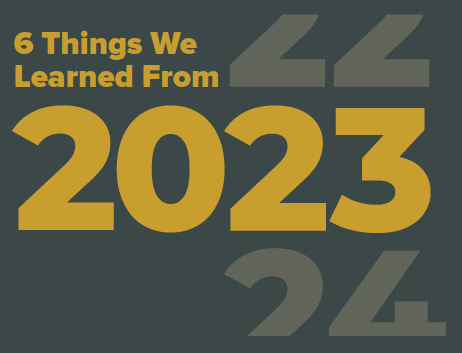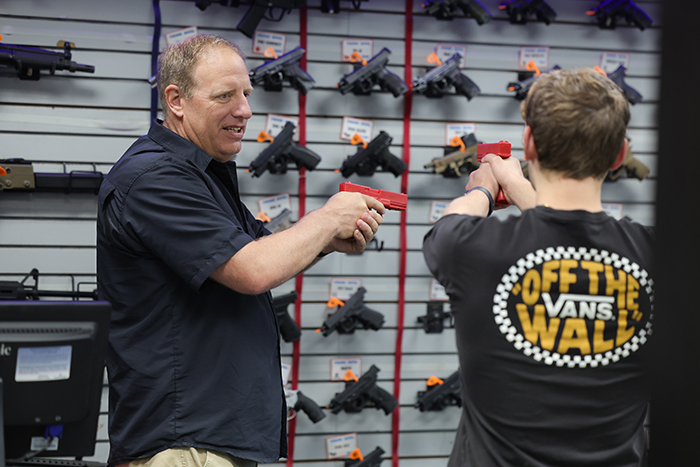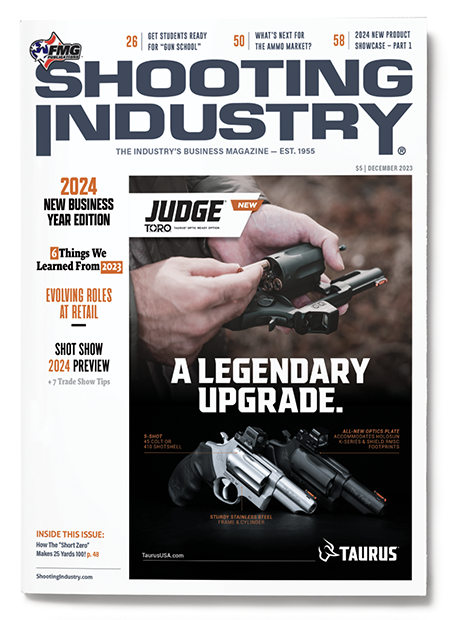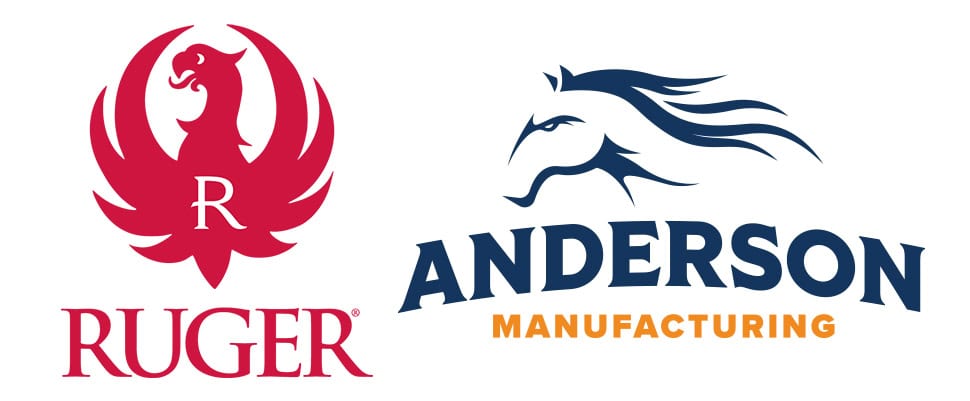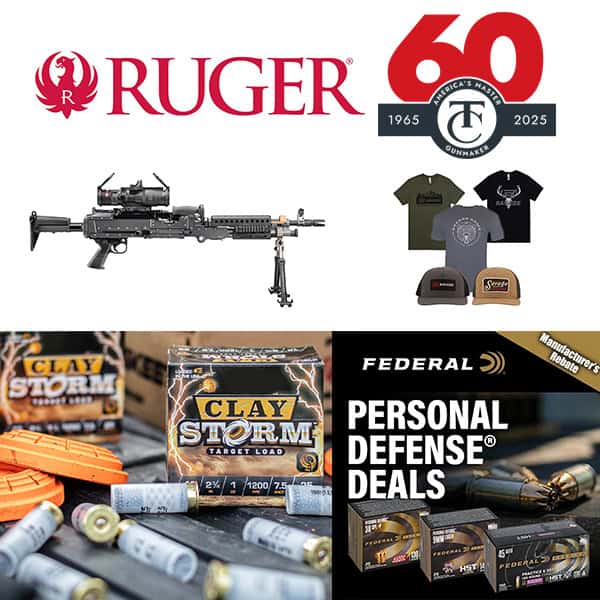6 Things We Learned From 2023
Relative to our recent years of turmoil, 2023 has been a fairly tame affair. As with all other years, this one has its defining characteristics.
Before we turn the page on 2023 and start looking at 2024, it’s time to take a look back and see what we learned. To help do this, we asked four dealers from across the country to share their thoughts.
Our panelists: Jacquelyn Clark, owner of Bristlecone Shooting in Lakewood, Colo.; John Phillips, president of Poway Weapons & Gear (PWG) in Poway, Calif.; Larry Hyatt, owner of Hyatt Guns in Charlotte, N.C.; and Paul Bastean, managing director of Ultimate Defense Firing Range & Training Center in St. Peters, Mo.
So, let’s look at some of the trends — some new, some emerging — from 2023.
1. Handgun Optics Are Not Just A Fad
Can you think of a significant firearms manufacturer that isn’t offering at least one model ready for a red dot? We even have revolvers — from Taurus — jumping into the pool. But what about the demand for these guns?
Clark answered, “Yes, but at the right price point. We’ve had some success at the lower price point (think Holosun), but not at the higher end.”
According to Bastean, Ultimate Defense heavily promotes handgun optics for a variety of applications, including plinking and self-defense.
“Most of our local law enforcement has switched to red dot sights. A lot of people tend to emulate what law enforcement is doing. So, it’s definitely one of the growth areas we saw in 2023,” he observed.
Optics are particularly appealing to older customers, and anyone with vision challenges, according to Hyatt.
“The optic fixes that. They’ve got them small enough now you can carry them. We’re still running behind on holsters and ways to carry them, but it’s very popular,” he confirmed.
Customer favorites?
“It’s all over the board,” Hyatt said. “You always have the group who wants the best. And you also have the ones who are looking for the cheapest. And then others are in between.”
At PWG, adaptation has been a little slower due to California’s strict laws about which guns can and cannot be sold in the state. Presently, there are no optic-ready guns on the approved roster.
“You have to make fundamental changes to the firearm to add an optic,” Phillips pointed out. “But people are doing it; they’re spending the extra money for the new slides. It means the lower-priced optics are certainly easier to sell.”
2. Sales Are Slowing
Sooner or later, the fear-fueled sales surge had to slow down and by the end of summer, it was happening across the country.
“Things are starting to pick up slightly for the holiday season, but even that is somewhat slower than normal,” Clark noted. “One thing we’ve learned this year, and I’m sure the industry has experienced the same thing, is we’re not immune to general economic slumps. It feels like people have less discretionary income to participate in classes or to buy higher-end accessories.”
Again, California’s unique firearms laws tend to make it more difficult to draw comparisons with the rest of the nation. Things were slowing down in the summer and early fall.
“Then our governor announced he’s going to go after an 11% tax hike on firearms and ammunition,” Phillips shared. “So, we’re already starting to see people come in and buying to get ahead of that.”
Hyatt forecasts a tough market.
“You know, we’ve been on top of the mountain for several years, selling everything we can get but now things have changed,” he said. “Production is higher than demand. Once that happens, you have problems with pricing and problems tying money up for dealers. This is going to be a tough market for the next little bit.”
For now, at least, the industry has lost many of the external forces that were driving intense customer demand.
“We don’t have riots and social unrest. We don’t have COVID driving sales. So, the combination of factors have hit and we’re going to see slower, but not bad sales,” Hyatt added.
At Ultimate Defense, Bastean has seen contrasting fortunes with new and used guns.
“New gun sales are probably our worst. Ammunition has slowed down considerably, but we’ve done really well with used guns — especially with the baby boomers passing. We just picked up 304 guns two days ago from an estate after a baby boomer passed.”
What’s to blame for the slowdown?
“Nobody knows with 100% certainty,” Bastean replied. “The assumption is the economy. There just doesn’t seem to be as much disposable income as there has been in years past. Our clientele is middle class and for us, we can sell guns for up to $500 with no problem. Then there seems to be a gap between $500 and $1,500. Those guns are the most difficult to sell. Then you get into the higher-end stuff, where we have no problem selling a $15,000 machine gun.”
3. Inventory Choices Are Back
Gone, for now at least, are the days of worrying about how you are going to fill those empty display cabinets. It’s not perfect yet, but most manufacturers are able to supply what you need.
“We can pretty much get anything we want to at this point,” Bastean noted. “The unfortunate thing is there hasn’t been anything introduced that’s ‘groundbreakingly’ exciting with people lined up around the block to get it. I think COVID hit R&D pretty hard. So, the models coming out right now are just modifications of an existing model.”
Slower sales and easy access to inventory can create issues for dealers that bring in more inventory than they can comfortably move, according to Hyatt.
“A retail store has huge amounts of capital. If you have to borrow money today, the interest rates are so much higher, which is a huge cost. Forecasting sales with a drastic change in demand is very difficult. Do I buy 10 or do I buy five? The buyers will really have a hard time because everything they had to do during the last three years doesn’t work now,” he said.
When it comes to production guns, Phillips says supply has been restored. The challenge has been with guns produced on a more modest scale.
“You can get what you want with the polymer firearms and the mass-produced stuff, but we’re still behind on some of the harder-to-get items. Some of the revolvers and lever actions are still behind. So, I’d say we’re getting close to back to ‘normal’ — but on some of the harder, non-polymer products, it’s still a little bit lagging.”
Says Clark, “It’s so much better than two or three years ago, it’s hard to even remember what it was like during COVID when you couldn’t get stuff and the lead times were ridiculous.”
Customers, it seems, also tend to have short memories.
“If somebody places a special order and it’s not there like the next morning, they’re wondering where it is,” Clark noted.
4. It’s Going To Take Creativity To “Woo” Customers
When sales slow, it’s no longer enough to just open your doors each day and wait for customers to find you. It’s time to break out your best marketing ideas to draw in customers, both old and new.
“We haven’t tried anything that works as good as sweat advertising — taking extra time on the phone, where you’ve got that one minute to talk to a customer one-on-one. Don’t just give them a price or say you don’t have something. Talk to them a little longer and give them a reason to want to come to your store,” Hyatt said.
Adding value is essential, Clark emphasized.
“You’ve got to be much more creative from a marketing and promotional standpoint. We’re coming up with new ideas and ways to bundle products so people will feel like they’re getting more value for their dollar,” she said.
For Bristlecone Shooting, this means putting together a package deal with a rifle, optics and ammo, showing how much the items would cost if purchased separately. Another offers “staff picks,” with various staffers choosing a favorite gun, optic or accessory, with those promoted in the store and on social media. There’s a firearms instructor at the range on Tuesday nights, offering free advice to customers.
And then there’s “The descent” — taking something that’s been in inventory for too long and dropping its price every Friday until it sells.
“People like watching stuff like that on social media and in the store,” Clark shared.
According to Bastean, Ultimate Defense is always looking for ways to use its range to create events that will keep customers interested. Among them is a gun-of-the-month promotion where customers buy themed targets (it was pumpkins in October) and then get raffle tickets based on how well they shoot those targets. In one recent month, the prize was an overstocked handgun with a red dot.
“Retail on the gun was like $650. We pulled in $1,100 in the raffle. So, we got rid of a gun that was a slow mover for us and we ended up selling it for double retail,” he remarked.
PWG’s robust membership gives Phillips a reliable revenue stream when retail sales are down.
“Even though things have slowed down, we saw a 30% growth in membership last year. We’re over about 9% this year. So, with our growth and memberships, we see the loyalty from foot traffic and people shooting and coming to use their membership. It helps us kind of navigate the slower times,” he offered.
5. Compete Effectively With Online Stores
Competing purely on price with online operations is a challenge. What can brick-and-mortar stores do to level the playing field?
To Hyatt, it’s a simple formula.
“First, join them. Have an online site you use just like the old Yellow Pages. You can update it any time and advertise your products, services and geographical advantage,” he said. “Second, carry inventory a mile wide and an inch deep to attract customers. Third, do transfers; $49 is a good number. Get the customer in your store. Be nice. Sell them accessories. Fourth: carry primers, powder, shot. It’s very expensive to ship. Fifth: gunsmith service.”
Phillips also recommends conducting transfers and using it as an opportunity to educate a customer.
“We charge transfer fees for people who bring in firearms,” he informed. “And we educate people as to what they think they’re saving. Often, when the dust settles, they really haven’t saved as much as they thought they did. Sometimes they’re upside down.”
Likewise, Clark sees the bigger picture when it comes to transfers.
“You have to compete on a personal level and offer extra value,” she reasoned. “There are some dealers who are reticent to do transfers, but from the consumer’s point of view, they’re just looking for the best price. A guy recently came into the store for a transfer and we took really good care of him. He ended up buying a membership. He bought a class — and he wrote a five-star review. That’s what we compete on, not necessarily the price of a GLOCK 19.”
At this point, Bastean conceded there’s no sense in avoiding the online marketplace, which accounts for 40% of his shop’s business. “You’re not going to fight the modernization of the shopping world. If you’re not going to engage the consumer in online shopping, then it’s just a matter of time before you’re not going to be a competitive factor anymore,” he urged.
6. Manufacturer Rebates Are
A Double-Edged Sword
Just like you, firearms manufacturers are looking for ways to generate interest and sales. Sometimes this means giving away magazines and other accessories you might otherwise sell customers. How does this impact your shop?
“They absolutely hurt us,” Phillips stated. “I’ve told every manufacturer that will listen to us they want us to sell our highest-cost, lowest-margin product, which is their firearms. Then they want to go out and give away our lowest-cost, highest-margin products.”
Cash rebates are a much better option — allowing the customer to immediately use the windfall on magazines or other accessories.
“That’s the way the manufacturers should be doing it,” Phillips continued, “but it’s easier to give away free products to move their guns. They really don’t care if it hurts the retailer.”
Clark welcomes when a manufacturer offers free guns with larger inventory purchases, which can make great items for in-store prizes. Even the accessory giveaways can help.
“We usually promote those directly to the consumers. There’s moderate success as far as actually bringing in people who are looking for a deal,” she informed.
Hyatt sees some potential benefits to giveaways, but only if the manufacturers market them in a way to bring customers into the store. It does no good if the customer only learns about the deal from in-store displays, he says.
“It’s how the factory gets the information to the consumer that’s going to help us the most,” Hyatt lends.
Bastean highlighted these incentives can be a double-edged sword.
“Absolutely, it helps, especially if you have somebody who is kind of stumbling over a decision. That incentive can help someone trying to make a justification as to why they should spend the money,” he noted. “But sometimes it’s a double-edged sword, too. Springfield Armory does its magazine promotion enough that people will hesitate and wait for the next magazine giveaway.”
Which of these six observations stands out to you the most? What would you add? We want to hear from you! Connect with us on Facebook, LinkedIn or by email — editor@shootingindustry.com.

